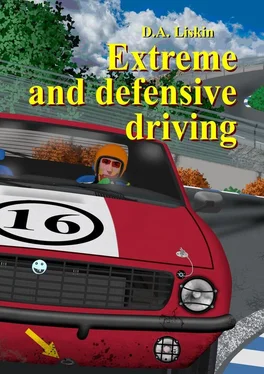Dmitry Liskin - Extreme and defensive driving
Здесь есть возможность читать онлайн «Dmitry Liskin - Extreme and defensive driving» — ознакомительный отрывок электронной книги совершенно бесплатно, а после прочтения отрывка купить полную версию. В некоторых случаях можно слушать аудио, скачать через торрент в формате fb2 и присутствует краткое содержание. ISBN: , Жанр: Спорт, на английском языке. Описание произведения, (предисловие) а так же отзывы посетителей доступны на портале библиотеки ЛибКат.
- Название:Extreme and defensive driving
- Автор:
- Жанр:
- Год:неизвестен
- ISBN:9785005372321
- Рейтинг книги:4 / 5. Голосов: 1
-
Избранное:Добавить в избранное
- Отзывы:
-
Ваша оценка:
- 80
- 1
- 2
- 3
- 4
- 5
Extreme and defensive driving: краткое содержание, описание и аннотация
Предлагаем к чтению аннотацию, описание, краткое содержание или предисловие (зависит от того, что написал сам автор книги «Extreme and defensive driving»). Если вы не нашли необходимую информацию о книге — напишите в комментариях, мы постараемся отыскать её.
Extreme and defensive driving — читать онлайн ознакомительный отрывок
Ниже представлен текст книги, разбитый по страницам. Система сохранения места последней прочитанной страницы, позволяет с удобством читать онлайн бесплатно книгу «Extreme and defensive driving», без необходимости каждый раз заново искать на чём Вы остановились. Поставьте закладку, и сможете в любой момент перейти на страницу, на которой закончили чтение.
Интервал:
Закладка:
Thus, traction on the front wheels when braking creates oversteer. Presence of a small traction on the front wheels during braking is equivalent to shifting balance of braking effort to the rear axle. But too much traction on the front wheels can lead to straightening of trajectory (understeer).
In addition to the previous reasons, drift can be caused by a sharp change in the road surface. For example, if a driver inadvertently drove a rear wheel to wayside of the road on which there is ground or snow, car can drift. An inexperienced driver, as a rule, does not operate with information about condition of the road surface and how it should affect the braking path and control technique. If you move in the “normal” tempo, familiar for dry weather, a rear-wheel-drive car can easily start drift at exit of corner on a wet road. Another danger may be invisible ice under the snow. Unsuspecting driver moving quite calmly on the road or passing a corner, can hit into emergency situation.
You can create oversteer in all the ways that you can create rear axle drift. For example, shifting the brake balance to the rear axle will increase steerability when braking at entry to a corner. On a front-wheel-drive car steerability can be improved by using the throttle and brake pedals together.
Ways to go out of drift
Front-wheel-drive
Consider ways to get out of drift. At first consider the front-wheel-drive type. We will provoke drift by the hand brake. When the rear axle begins drift, we must press the throttle pedal to 100% and direct the front wheels against direction of drift to stop the drift.
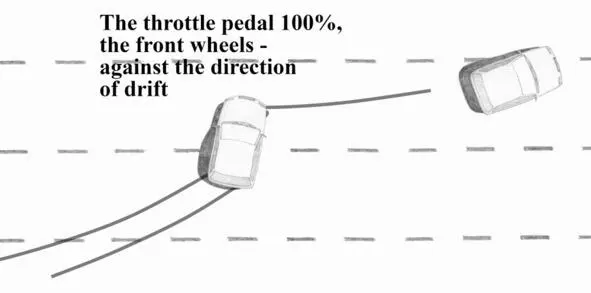
There are noticeable traces left by locked rear wheels during the action of the handbrake. The first was locked the unloaded wheel. After the end of handbrake action, the throttle pedal was pressed and the steering wheel was turned against of the drift direction. It may be seen unloaded front wheel began to grind after pressing the throttle pedal. This is explained by the fact the machine has a zero-friction differential. Before the end of the drift the steering wheel was returned to the “straight” position, after the throttle pedal was released.
The psychology of an untrained driver forces him to release the throttle pedal when a drift occurs, regardless of the drive type. This is a common error in driving a front-wheel-drive car. Finding himself in an unfamiliar situation, overcame by sense of fear, the driver releases the gas pedal. So the drift increases. Eventually, driver loses control over the car, the car continues to move by inertia, as if there is no driver in it.
For successful exit from any angle of drift on a front-wheel-drive car engine torque must be enough, to keep skidding of the front wheels at least on the first gear, otherwise the engine will fail. If drift angle of 90 degrees or more occurs it is likely, that you will have to lower the gear, to increase torque on the front wheels.
Rear-wheel-drive
On a rear-wheel-drive car the throttle pedal must be released when exiting from drift. Let us take a rear-wheel-drive understeer car. We will provoke drift of the rear axle by pressing the throttle pedal roundly when passing a corner. To stop drift, depress the throttle pedal and turn the steering wheel against of drift direction. When drift begins to decrease, we will immediately return the steering wheel to the “straight” position.
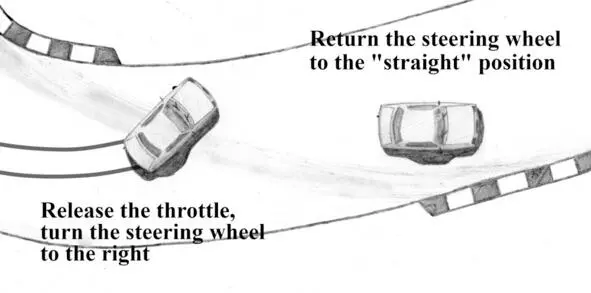
When exiting a drift with help of steering the maximum drift angle from which you can exit depends on the maximum turn of the front wheels. Note that during exit from drift, the front wheels of the car are directed along the direction of movement. If a zero-friction differential is installed on the rear axle and no friction is created inside the differential when negative load, then braking by the engine will create noticeable oversteer. Therefore, in the case of zero-friction differential, it is better to squeeze the clutch during fight with drift, to exclude engine braking.
At next, we will try an experiment. Let us see, what happens if press together the throttle and brake pedals, while the car is in a drift.
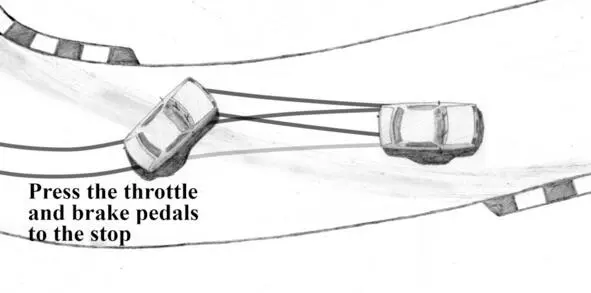
During pass the corner we provoke drift by throttling. Then we hit the throttle and brake pedals at the same time. The front wheels were locked, and there was traction from the engine retained on the rear wheels. Rear unloaded wheel began to skid. Trajectory straightened and drifting stopped. There are visible tyre traces, left by locked front wheels and unloaded rear wheel, which slipped on the asphalt.
Consider what happened to each axle when the throttle and brake pedals were pressed together. Since the drive is carried out on the rear wheels, the front wheels will only be affected by the braking effort, which causes the front wheels to lock. Locked front wheels cause understeer. Now let us look at what happens to the rear axle. For now imagine, that the rear axle has a zero-friction differential. The rear wheels will have braking efforts and equal engine torques.
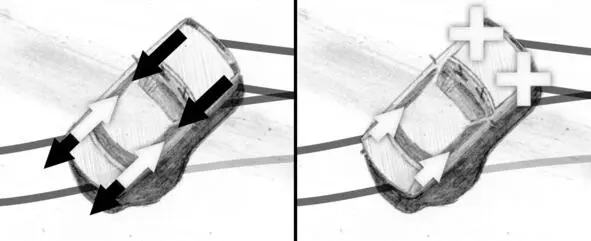
The left figure shows equivalent forces, created by braking (black arrows), and equivalent forces, caused by engine torque (white arrows). At the right figure the resulting equivalent forces on the rear wheels are shown in white arrows. High braking effort on the front wheels locked them. On the rear axle a small traction was retained. As you know, traction on the rear wheels leads to loading the rear axle and unloading the front. To lock the front wheel is easier, when the front axle is less loaded. As a result, conditions for understeer are created.
The torque on the rear axle can be adjusted so that the braking effort is compensated: neither traction nor braking effort will act on the rear wheels. In this case only the front wheels will brake, which is similar to a strong shift of brake balance to the front axle. As for power, it is distributed unevenly between the wheels: zero-friction differential transfers the main part of engine power to the unloaded wheel.
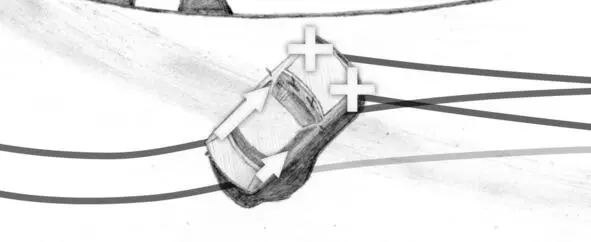
At the figure the arrows show the power transmitted to the rear wheels.
The torque on unloaded rear wheel causes it to spin rapidly and skid on the road surface. When the trajectory gradually straightens and roll of the body decreases, the unloaded wheel regains grip on the road, speed of rotation gained by it decreases sharply. At that there is a push against the direction of drift, which causes the trajectory to straighten even more.
If a high-friction differential is installed on the rear axle, more engine torque will be transmitted to rear loaded wheel, than to rear unloaded wheel. When the throttle and brake pedals are pressed at the same time, there will be less understeer, than in the case of a zero-friction differential, since the increased torque on rear loaded wheel will push the car in the direction of increasing drift.
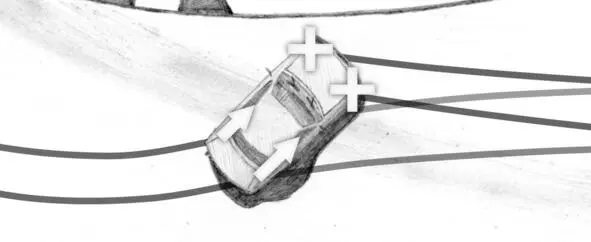
The figure shows the total equivalent forces, when a high-friction differential is installed on the machine. A high-friction differential transfers more than half of engine’s torque to rear loaded wheel. The increased traction on rear loaded wheel pushes the car even deeper in the direction of drift (to the left in the figure plane). An addition increase of the torque on rear loaded wheel leads to an increase of engine power transmitted to this wheel.
Читать дальшеИнтервал:
Закладка:
Похожие книги на «Extreme and defensive driving»
Представляем Вашему вниманию похожие книги на «Extreme and defensive driving» списком для выбора. Мы отобрали схожую по названию и смыслу литературу в надежде предоставить читателям больше вариантов отыскать новые, интересные, ещё непрочитанные произведения.
Обсуждение, отзывы о книге «Extreme and defensive driving» и просто собственные мнения читателей. Оставьте ваши комментарии, напишите, что Вы думаете о произведении, его смысле или главных героях. Укажите что конкретно понравилось, а что нет, и почему Вы так считаете.
